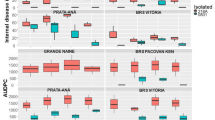Abstract
Ecological properties and stability of benomyl resistance of three benomyl-resistant mutants of nonpathogenicFusarium-isolates antagonistic to fusarium wilt in carnation, and three benomyl-resistant mutants of a pathogenic isolate ofFusarium oxysporum f.sp.dianthi were evaluatedin vitro and in glasshouse experiments. The benomyl resistance of the nonpathogenic mutants was stable under all conditions tested, also after a 1000-fold increase of the population in sterilized soil. Mutants of the pathogen were stable during allin vitro tests, but after proliferation in carnation stems only part of the population was benomyl resistant.
Compared to the wild type, mutants of the pathogen were less pathogenic, also if thein vitro propeties were similar. Colonization of carnation by benomyl-resistant nonpathogenicFusarium in the presence of the pathogen showed that the antagonistic effect correlated with the presence of the nonpathogenic isolates within the carnation stem. The wild types and two of the mutant nonpathogenicFusarium-isolates controlled fusarium wilt in the susceptible cultivar Lena for 50% or more.
UV-induced benomyl resistance appeared to be a valuable marker to distinguish between differentFusarium isolates and to study the population dynamics, but intensive screening of the mutants is a prerequisite since alterations in antagonism and pathogenicity can occur.
Similar content being viewed by others
References
Alabouvette, C., de la Broise, D., Lemanceau, P., Couteaudier, Y. & Louvet, J., 1987. Utilisation de souches non pathogènes deFusarium pour lutter contre les fusarioses: situation actuelle dans la pratique. EPPO Bulletin 17: 665–674.
Andrews, J.H., 1986. How to track a microbe. In: N.J. Fokkema & J. van den Heuvel (Eds), Microbiology of the phylosphere. Cambridge University Press, Cambridge. p. 14–34.
Baayen, R.P. & Niemann, G.J., 1989. Correlations between accumulation of dianthramides, dianthalexin and unknown compounds, and partial resistance toFusarium oxysporum f.sp.dianthi in eleven carnation cultivars. Journal of Phytopathology 126: 281–292.
Couteaudier, Y. & Alabouvette, C., 1990a. Survival and inoculum potential of conidia and chlamydospores ofFusarium oxysporum f.sp.lini in soil. Canadian Journal of Microbiology 36: 551–556.
Couteaudier, Y. & Alabouvette, C., 1990b. Quantitative comparison ofFusarium oxysporum competitiveness in relation to carbon utilization. FEMS Microbiology Ecology 74: 261–268.
Cugudda, L. & Garibaldi, A., 1987. Soil suppressive toFusarium wilt of carnation: studies on mechanisms of suppressiveness. Acta Horticulturae 216: 67–76.
Cullen, D. & Andrews, J.H. 1985. Benomyl-marked populations ofChaetomium globosum: survival on apple leaves with and without benomyl and antagonism to the apple scab pathogen,Venturia inaequalis. Canadian Journal of Microbiology 31: 251–255.
Dekker, J., 1984. Development of resistance to antifungal agents. In: A.P.J. Trinci & J.F. Lyley (Eds), Action of antifungal agents. Cambridge University Press, Cambridge. p. 89–111.
Eparvier, A., Lemanceau, P. & Alaboubette, C., 1991. Population dynamics of non-pathogenicFusarium and fluorescentPseudomonas strains in rockwool, a substratum for soilless culture. FEMS Microbiology Ecology 86: 177–184.
Garibaldi, A., Guglielmone, L. & Gullino, M.L. 1991. Role of rhizosphere competence on antagonistic activity of saprophyticFusarium spp. In: A.B.R. Beemster, G.J. Bollen, M. Gerlagh, M.A. Ruissen, B. Schippers & A. Tempel (Eds), Biotic interactions and soil-borne diseases. Elsevier, Amsterdam. p. 301–305.
Gordon, T.R., Okamoto, D. & Jacobson, D.J., 1989. Colonization of muskmelon and nonsusceptible crops byFusarium oxysporum f.sp.melonis and other species ofFusarium. Phytopathology 79: 1095–1100.
Kroon, B.A.M. & Elgersma, D.M., 1991. Induction of mutants ofFusarium oxysporum f.sp.lycopersici with altered virulence. Netherlands Journal of Plant Pathology 97: 409–416.
Lemanceau, P., Bakker, P.A.H.M., de Kogel, W.J., Alabouvette, C. & Schippers, B., 1992. Effect of pseudobactin 358 production byPseudomonas putida WCS358 on suppression of fusarium wilt of carnations by nonpathogenicFusarium oxysporum Fo47. Applied and Environmental Microbiology 58: 2978–2982.
Mattusch, P., 1990, Biologische Bekämpfung vonFusarium oxysporum an einigen gärtnerischen Kulturpflantzen. Nachrichtenblatt des Deutschen Pflantzenschutzdienstes 42: 148–150.
Papavizas, G.C. & Lewis, J.A., 1983. Physiological and biocontrol characteristics of stable mutants ofTrichoderma viride resistant to MBC fungicides. Phytopathology 73: 407–411.
Papavizas, G.C., Lewis, J.A. & Abd-El Moity, T.H., 1982. Evaluation of new biotypes ofTrichoderma harzianum for tolerance to benomyl and enhanced biocontrol capabilities. Phytopathology 72: 126–132.
Postma, J. & Rattink, H., 1991. Biological control of fusarium wilt of carnation with nonpathogenicFusarium isolates. Mededelingen van de Faculteit Landbouwwetenschappen Rijksuniversiteit Gent 56/2a: 179–184.
Postma, J. & Rattink H., 1992. Biological control of fusarium wilt of carnation with a nonpathogenic isolate ofFusarium oxysporum. Canadian Journal of Botany 70: 1199–1205.
Rattink, H., 1987. Possibilities of cross-protection against fusarium wilt by nonpathogenic isolates ofFusarium f.sp.dianthi. Acta Horticulturae, 216: 131–140.
Seidel, R., Chitzanidis, A. & Kranz, J., 1990. Pathogenic and relative fitness of thiabendazole-resistant and sensitive strains ofPenicillium digitatum. Zeitschrift für Pflanzenkrankheiten und Pflanzenschutz 97: 65–71.
Sivan, A. & Chet, I., 1989. The possible role of competition betweenTrichoderma harzianum andFusarium oxysporum on rhizosphere colonization. Phytopathology 79: 198–203.
Tramier, R., Antonini, A. & Bettachini, A., 1987. Possiblities of biological control againstFusarium oxysporum dianthi. Acta Horticulturae 216: 63–66.
Author information
Authors and Affiliations
Rights and permissions
About this article
Cite this article
Postma, J., Luttikholt, A.J.G. Benomyl-resistant Fusarium-isolates in ecological studies on the biological control of fusarium wilt in carnation. Netherlands Journal of Plant Pathology 99, 175–188 (1993). https://doi.org/10.1007/BF01974662
Accepted:
Issue Date:
DOI: https://doi.org/10.1007/BF01974662




